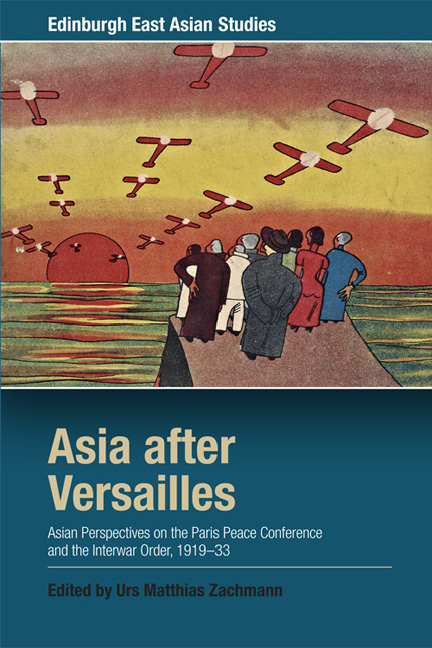 Asia after Versailles
Asia after Versailles from Part I
Published online by Cambridge University Press: 22 December 2017
In the past decade, the focus of the debate on ‘Asia’ as a political concept has shifted from examining what ‘Asia’ means to how ‘Asia’ means. The major inspiration for this new Asia discourse is derived from the writings of the Japanese Sinologist and critic Takeuchi Yoshimi (1910–77). In ‘Asia as method’ (1961), Takeuchi had distinguished between ‘Asia as an object’ (taishō) and ‘Asia as a method’ (hōhō). Advancing the latter, Takeuchi provided relief from the search for Asia's distinctive substance (jittai), which almost inevitably leads to the conclusion that, historically Asia is a heterogeneous and eventually empty, foreign-imposed category, nothing but the West's ‘backward’ Other. Instead, Takeuchi proposed grasping Asia primarily as a method to criticise defects of Western modernity. This critique, according to Takeuchi, could consecutively generate a process of Asia's self-formation. In addition, by applying ‘Asia as a method’ to the West, Asia could transform the West itself ‘in order to raise to a higher level the universal values that were themselves engendered by the West’. In the present-day politico-intellectual discourse, which links the critique of capitalism and globalisation to the debate of Asia in general and to visions of an East Asian community in particular, public intellectuals throughout East Asia have arduously been promoting this Takeuchian understanding of Asia.
Historically, the First World War constitutes one of the first instances during which the concept of Asia was linked by people from different parts of Asia to criticism of the assumed superiority of Western modernity and of globalisation along Western standards. Encouraged by the self-destructive Great War and incited by continuous racial discrimination, numerous Asian thinkers embarked on a full-scale attack on European civilisation as the emblem of Western materialistic modernity. Simultaneously, the hitherto neglected concept of Asia was re-evaluated. Constrained by the legacies of the traditional Sinocentric order, in the case of China, and of the pursuit of ‘Europeanisationism’ (Japanese Ōkashugi), in the case of Japan, this embrace of Asia occurred only in a hesitant and piecemeal fashion. Asia's ‘Asia’ itself, both in its imagination and reality, needed to be transformed before Asians could speak affirmatively on behalf of ‘Asia’ to Asians and to the West.
To save this book to your Kindle, first ensure [email protected] is added to your Approved Personal Document E-mail List under your Personal Document Settings on the Manage Your Content and Devices page of your Amazon account. Then enter the ‘name’ part of your Kindle email address below. Find out more about saving to your Kindle.
Note you can select to save to either the @free.kindle.com or @kindle.com variations. ‘@free.kindle.com’ emails are free but can only be saved to your device when it is connected to wi-fi. ‘@kindle.com’ emails can be delivered even when you are not connected to wi-fi, but note that service fees apply.
Find out more about the Kindle Personal Document Service.
To save content items to your account, please confirm that you agree to abide by our usage policies. If this is the first time you use this feature, you will be asked to authorise Cambridge Core to connect with your account. Find out more about saving content to Dropbox.
To save content items to your account, please confirm that you agree to abide by our usage policies. If this is the first time you use this feature, you will be asked to authorise Cambridge Core to connect with your account. Find out more about saving content to Google Drive.